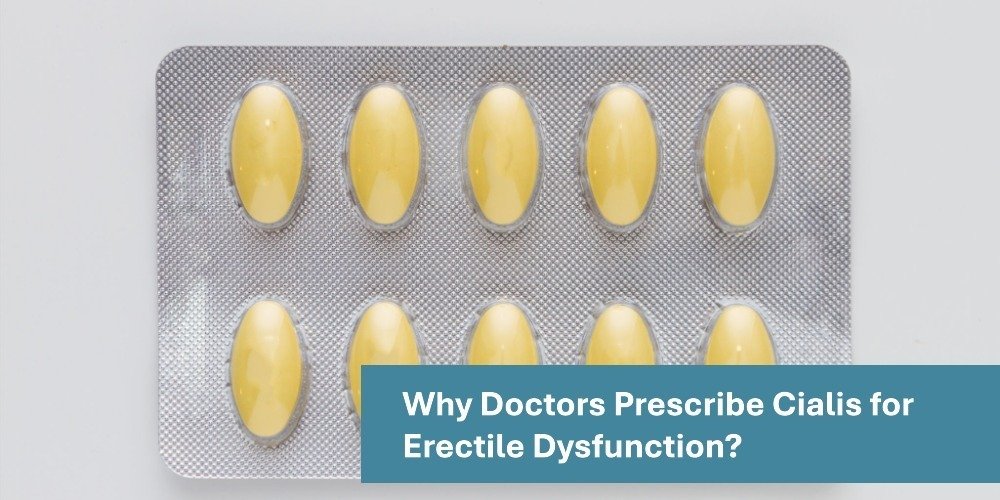Doctors prescribe Cialis for erectile dysfunction because it increases blood flow to your penis, helping you achieve and maintain an erection when sexually aroused.
Cialis Prescription For Erectile Dysfunction
How It Works
Cialis contains the active ingredient tadalafil, which belongs to a class of medicines called PDE5 inhibitors. This medicine blocks the enzyme PDE5, allowing the blood vessels in your penis to relax and widen. As a result, you experience improved blood circulation that supports a firm erection during sexual activity.
Duration of Action
One of the main reasons doctors choose Cialis is its long-lasting effect. Unlike other ED medications, Cialis can remain active in your body for up to 36 hours, giving you more flexibility and reducing pressure to plan sexual activity around a pill’s short timeframe.
Dosage Options
Cialis can be prescribed in two ways:
As-needed use: You take it before sexual activity, usually cialis 20mg tablet.
Daily use: A lower dose (2.5–5 mg) taken once daily, which maintains steady levels in your system. This option is helpful if you prefer spontaneity without planning ahead.
What Medical Conditions Make Cialis a Safer Choice for Me?
Cialis (tadalafil) is often preferred over other ED medicines in certain medical situations because of its longer duration, flexible dosing, and additional benefits. But whether it’s safer for you depends on your overall health and your doctor’s assessment.
Benign Prostatic Hyperplasia (BPH)
If you also have BPH (an enlarged prostate) along with erectile dysfunction, Cialis can be a safer choice. It improves urinary symptoms like difficulty starting urination, weak stream, or frequent night urination, so you get two treatments in one medication.
Controlled High Blood Pressure
For men with well-managed high blood pressure, Cialis is often safe. It doesn’t cause sudden blood pressure drops as aggressively as some other medications. However, you should not use it with nitrates (like nitroglycerin) or certain alpha-blockers, since that combination can dangerously lower blood pressure.
Diabetes
Erectile dysfunction is common in men with diabetes due to poor blood flow and nerve issues. Cialis may be a safer, reliable choice because it’s effective even in men whose ED is linked to long-term diabetes complications.
Heart Conditions (Stable Cases)
If you have stable cardiovascular disease (like mild, well-controlled angina or after recovery from a heart procedure) and your doctor has cleared you for sexual activity, Cialis can be prescribed. But it must be avoided if you’re on nitrates or have unstable heart problems.
Need for Flexibility & Spontaneity
Cialis may be a safer lifestyle choice for men who don’t want to take medication “right before” intimacy. Its 36-hour duration or low daily dosing reduces stress and planning, especially useful if you experience anxiety related to performance.
Why Might a Doctor Choose Daily Low-Dose Cialis Over as-needed Dosing?
A doctor might choose daily low-dose Cialis instead of the usual “as-needed” dose when it better fits your health condition and lifestyle.
Steady Levels in Your Body
Daily Cialis (2.5–5 mg once a day) keeps tadalafil at a stable level in your bloodstream. This means you’re always ready for sexual activity without having to plan around taking a pill.
More Natural & Spontaneous Intimacy
With as-needed dosing (10–20 mg), you usually have to take the tablet at least 30 minutes before sex. If you prefer intimacy to feel natural and unplanned, daily dosing avoids this scheduling.
Better for Men with Frequent Sexual Activity
If you’re sexually active several times a week, daily Cialis may be more practical and sometimes more cost-effective than taking multiple higher-dose tablets.
Helpful for Benign Prostatic Hyperplasia (BPH)
Daily Cialis also treats urinary symptoms caused by an enlarged prostate. If you have both ED and BPH, your doctor may recommend a daily low dose to manage both conditions at once.
Reduced Side Effects for Some Men
Since the daily dose is much lower, some men experience fewer side effects like headache, flushing, or indigestion compared to taking the higher as-needed dose.
What Clinical Factors Make Daily Low-Dose Tadalafil Preferable to as‑needed Dosing?
Doctors don’t just look at convenience when deciding between daily low-dose tadalafil (Cialis) and as-needed dosing. They also weigh clinical factors that affect safety and effectiveness.
Frequency of Sexual Activity
If you expect to have sex more than twice a week, daily dosing may be more suitable. It keeps tadalafil at steady levels in your body, avoiding the need to take a pill before every encounter.
Coexisting Benign Prostatic Hyperplasia (BPH)
Daily tadalafil (2.5–5 mg) is also approved for BPH, helping with urinary symptoms like weak stream or frequent nighttime urination. If you have both ED and BPH, daily treatment addresses both conditions.
Cardiovascular Stability
In men with stable cardiovascular disease who are cleared for sexual activity, daily low-dose therapy may reduce sudden cardiovascular stress compared with higher as-needed doses. It provides smoother, more predictable blood vessel relaxation.
Tolerability & Side Effect Profile
Daily use often means fewer side effects because the dose is lower (2.5–5 mg vs. 10–20 mg as needed). Men sensitive to headaches, flushing, or stomach upset from higher doses may tolerate daily dosing better.
Patient Preference for Spontaneity
For men who experience performance anxiety or dislike the “timing pressure” of taking a pill, daily tadalafil helps maintain confidence by allowing sexual activity anytime.
Metabolic or Chronic Health Conditions
Men with diabetes, hypertension, or mild kidney impairment may benefit from daily therapy because the low dose maintains a consistent effect without the peaks and troughs of on-demand use, reducing strain on the body.

